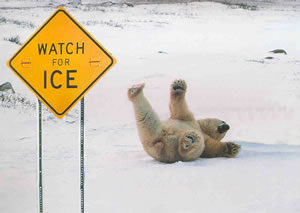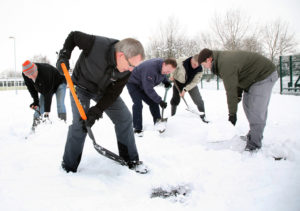Each year cold weather strikes, and with it comes inevitable winter injuries. Common orthopedic injuries due to cold weather can be attributed to falling on ice or snow, shoveling snow, or other winter activities. While injuries aren’t always able to be avoided, it can be helpful to know how they commonly occur and how to reduce your chance of injury. If an injury does occur, Dr. Lawrence Li and the rest of the staff at Orthopedic & Shoulder Center will get you back on your feet as quickly as possible.
Slipping on Ice
Slipping on ice is a common occurrence during with winter months. Ice is especially dangerous as it is difficult to see and differentiate from pools of water on pavement. Injuries due to ice typically occur because it is our natural reaction to try to catch ourselves, and then wrist and elbow injuries ensue. These injuries can range from sprains, contusions all the way to fracture. Ankle fracture and sprains can also happen as a fallen person is trying to regain their balance and stand up.
Avoid Falls:
Falls can happen, but with a few simple tips you can reduce your likelihood of a slip.
Proper Footwear:
It is important to remember to wear proper footwear. Yes, you may love your new pair of stiletto heels or broken-in pair of tennis shoes with little traction left, but unfortunately winter is not the time to wear them. If you must wear them, it is helpful to wear snow boots or other shoes with deep traction while you are outside and then change into these shoes once indoors. It is also important to make sure that you are wearing shoes with ankle support, these will allow you more stability and may help to prevent an ankle injury. Also remember to knock the snow off of your shoes when you enter a building, this can help prevent the snow from melting and causing you to slip on the water while inside.
Sprinkle Salt or Grit:
It is also advisable to put salt or other ice melts on your driveways, sidewalks, and stairs as frequently as possible. Shoveling driveways, sidewalks, and stairs can also help to keep you from slipping on ice or snow.
Walk like a Penguin:
Walk flatfooted, keeping your feet spread to broaden your base and keep your center of gravity forward. Keep your arms free and to your sides to help you maintain balance. Focus on where you are walking.
When A Fall Happens:
Sometimes falls are unavoidable and when they happen it’s best to know what to do. If you find yourself going down lean forward so that the back of your head and spine don’t hit the pavement. Remember to try not to catch yourself with your arms, as this often is how shoulder and arm injuries can happen. If you are falling forward, roll with the fall and if you are falling backward try to land in a seated position.
Shoveling and Injuries
While shoveling can help to keep you from falling on ice, it can cause injuries of its own. The U.S. Consumer Product Safety Commission shares that more than 158,000 people were treated for injuries that happened while removing snow in 2015. The most common were sprains, strains, and lacerations. To help avoid injuries it is important to keep a few tips in mind.
Warm Up:
Snow shoveling can be an arduous task so it is important to warm up like you would for any other physical activity. Some light exercise and stretching can help you to avoid hurting yourself.
Take Breaks:
Take frequent breaks so as not to strain your muscles. It will also help if you shovel early and often. Meaning shovel when it first starts to snow and continually shovel versus letting it all pile up, if possible.
Proper Technique:
Always try to push the snow instead of lifting it if possible. If you have to lift it, use proper technique. Always remember to never bend at the waist. Squat with your legs apart, back straight, and knees bent. Lift with your legs, not your back. Only lift small amounts and walk it to where you would like in dumped. “Throwing” the snow can lead to back and shoulder injuries.
This is exactly what NOT to do when shoveling.
Treatment
If you do injure yourself this winter, it is important to remember that ignoring the problem and hoping that it will heal on its own may lead to further injury. Dr. Li will be able to diagnose your injury and help you start the road to healing. If you have already experienced an injury this winter, schedule an appointment today to make sure that it doesn’t become worse.


